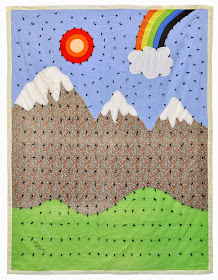 |
| "Fruity Beauty" 2015, detail |
Whenever I make a quilt, there is inspiration involved. The inspiration behind my "Fruity Beauty" quilt is the "New York Beauty", a complex American patchwork design that goes back to the middle 19th century. After writing a book on the subject, soon to be published by Quiltmania, I was inspired to make a New York Beauty. However, as a novice quiltmaker, I had to play to some of my other strengths.
 |
| the original photo source for the citrus fruit in "Fruity Beauty" |
Digital image editing is a self-taught skill for me. Photoshop was created around the time I got my undergraduate degree in photography. I didn't learn about it until ten years later, 1998, when I picked up a package with Photoshop, Illustrator and Pagemaker, the predecessor of InDesign.
 |
| The image was edited in Photoshop to remove the background and boost color |
I had five years of computer experience, all post-grad and self-taught, and was using Corel Draw and Pagemaker on a laptop purchased three years earlier. I also had a Casio QV10 digital camera, and later, the Sony Mavica. It was really the beginning of the digital age in photography, and ironically, it happened just after I'd completed the best college photography education money could buy.
 |
| Do you remember the Casio QV10? How about the Sony Mavica? |
Today, Photoshop and digital single lens reflex cameras (SLRs) are central to an education in photography, but back in the 80s and early 90s we were working with film cameras, roll and sheet film, photosensitive papers and chemical solutions. All my training was with materials that would soon be antiquated. Fortunately, all the concepts still apply. The tools are just different, and to be honest, I don't miss the chemicals.
 |
| I designed fabric using the edited digital images |
Learning Photoshop came naturally, and it was probably because of all those years of experience in the darkroom. Spoonflower, the print-on-demand fabric website that allows people to design and print their own fabrics, also came naturally. So, I came up with a digital-age solution to the problem of not knowing how to sew but wanting to make a New York Beauty quilt.
 |
| pieced quilt, c. 1880, Texas |
The traditional "New York Beauty" design, which got its moniker in 1930 from Mountain Mist, includes a radiating circle broken into four quarter-circle wedges or arcs. These wedges are placed in the corners of a block, with points radiating from the curved seams toward the center of the block. It is an advanced design, and quilts are made with rows of blocks, set with elaborately pieced sashing and small, radiating sunburst cornerstones. The intersecting points of four blocks revolve around the cornerstones, and the wedges in the corners of the four adjoining blocks form larger broken sunbursts.
The subject matter of "Fruity Beauty" was almost incidental at first. I wasn't as turned on by citrus fruits as I was by finding a simple way to make an elaborate looking quilt. When the quilt was finished, I felt it had all come together nicely and I'd gotten behind the citrus fruit. Roughly speaking, the shapes could stand in for those found in the traditional design.
 |
| wood juicers |
One of the details I love is the color of the wood juicers in the sashing. If you look at a lot of antique quilts such as the 1880s example pictured in this blog, often you will see tan fabric that has faded from its original, more saturated color.
As mentioned in the previous blog, this four-block quilt is a sample. I plan to make a larger one with 16 blocks, and may play around with it just a bit. It may take a little while to get back to the project, lots going on in the first few months of the year, but it's nice to have the sample done.






















































